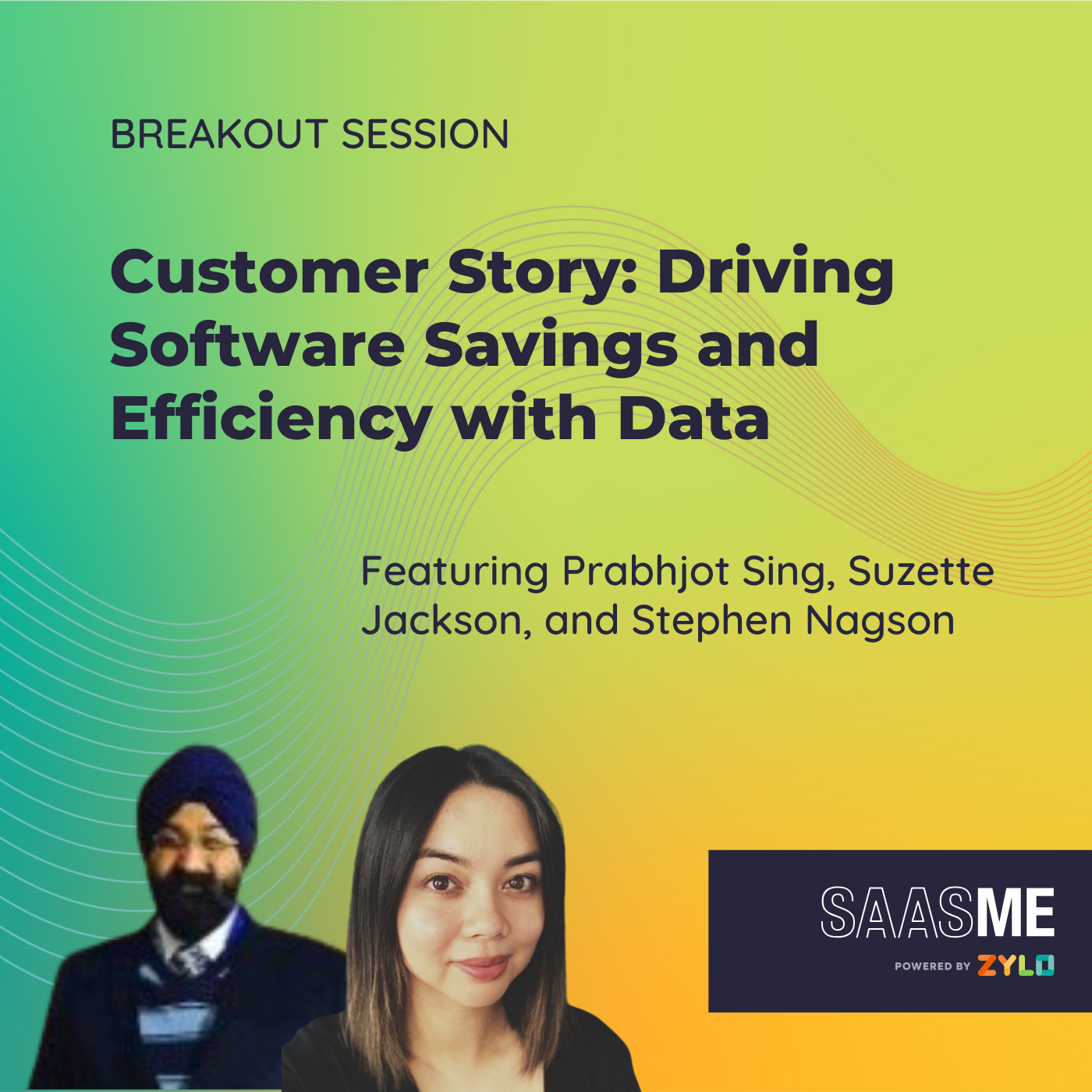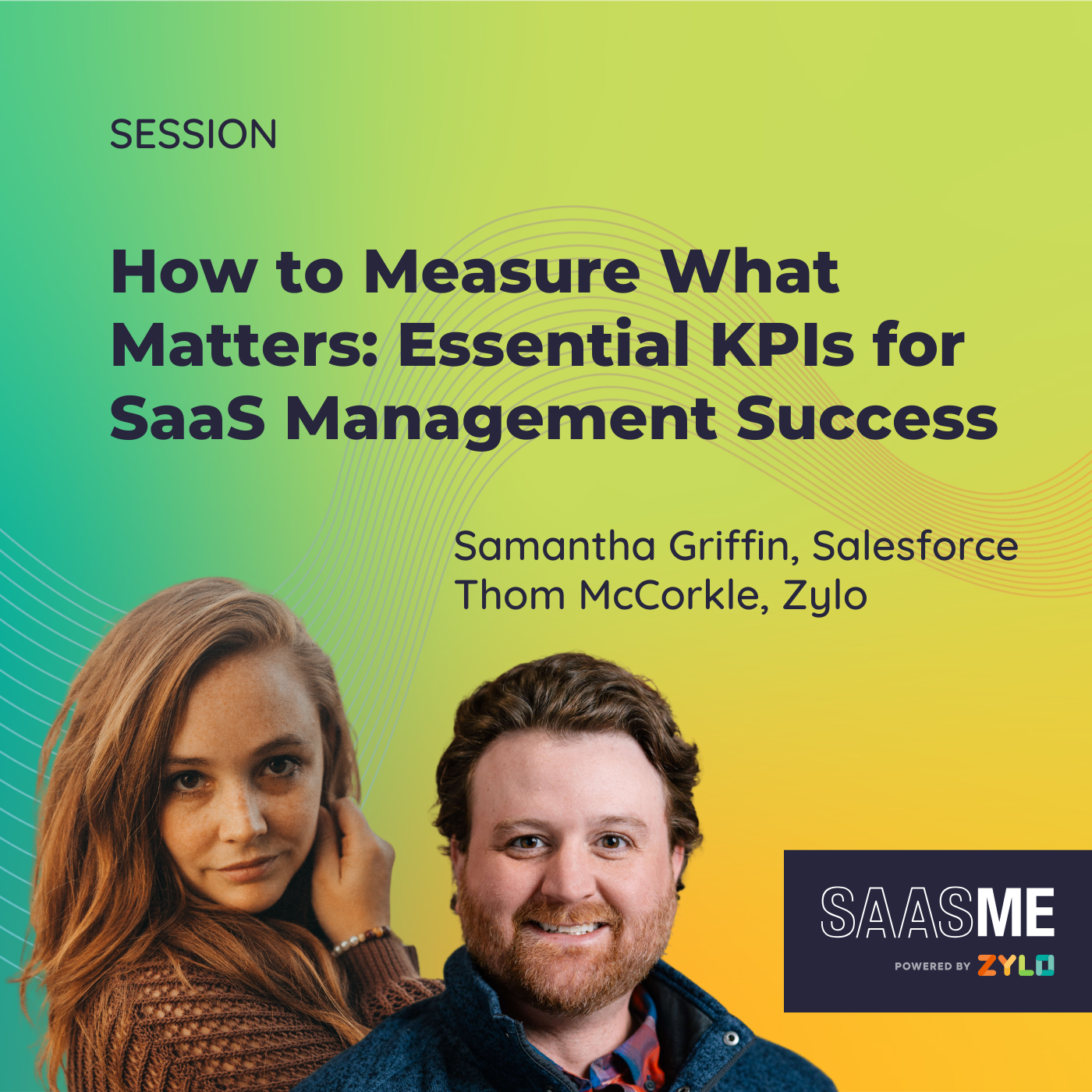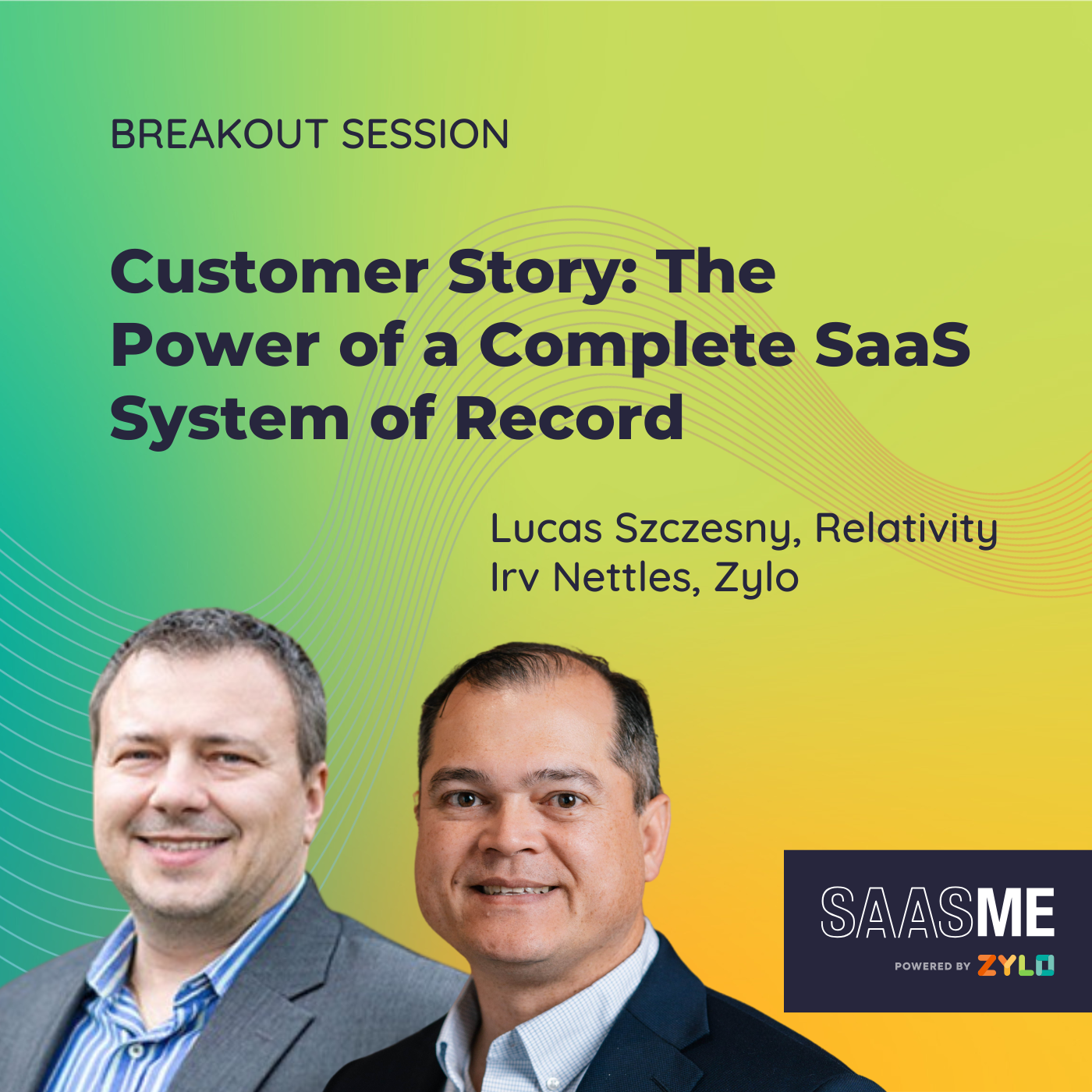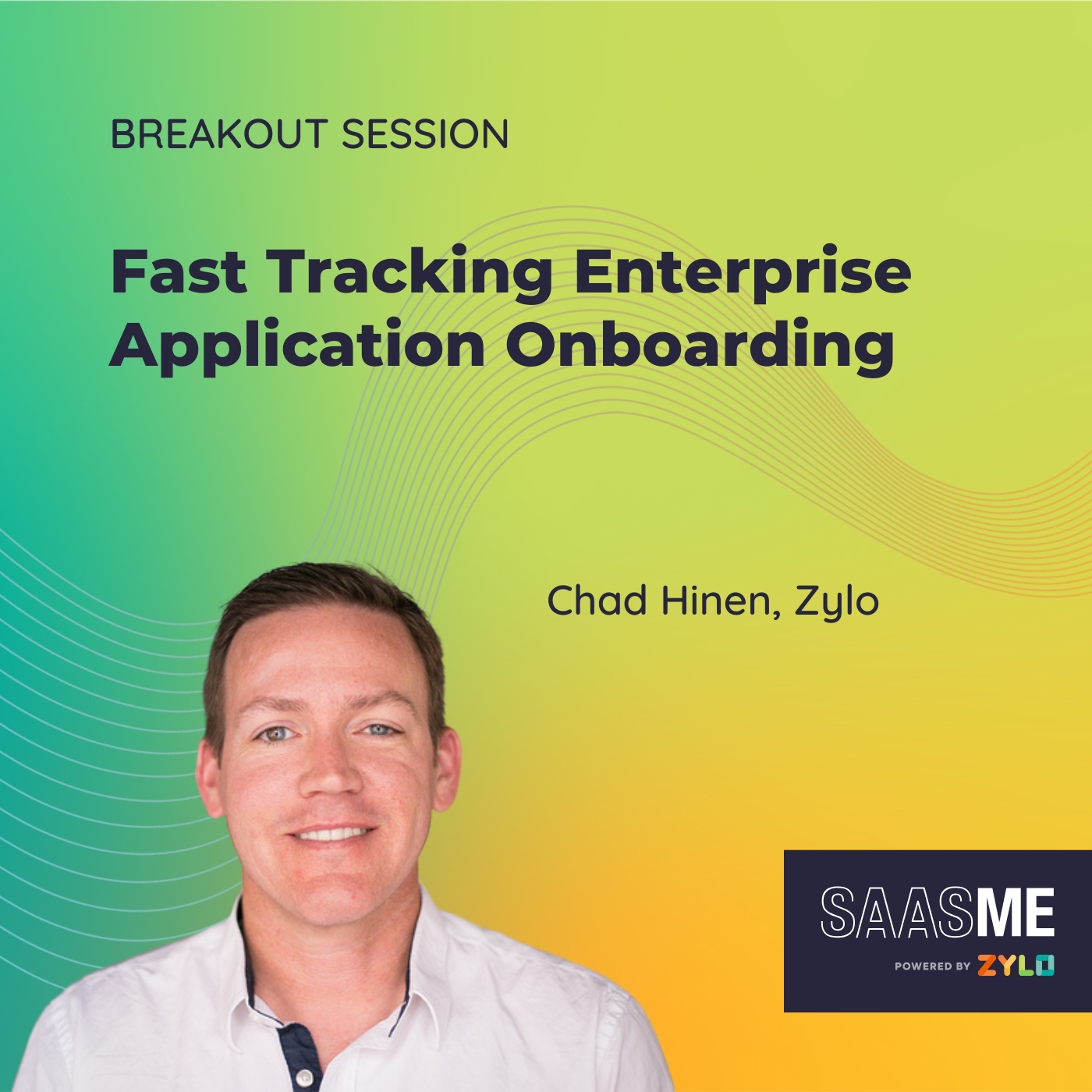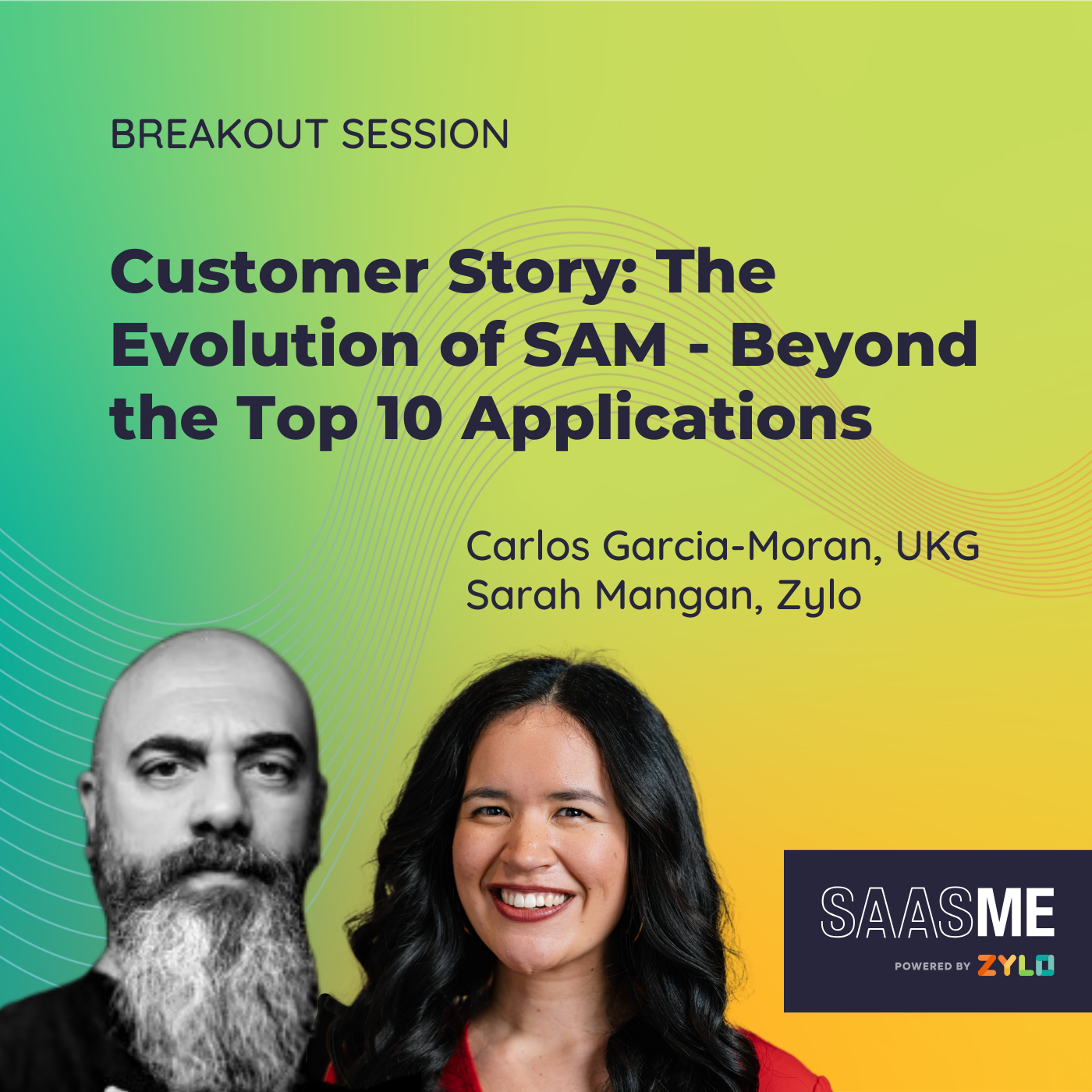Customer Story: Driving Software Savings and Efficiency with Data
- 0.5
- 1
- 1.25
- 1.5
- 1.75
- 2
Brittany Linville: Hi everyone. I hope you're enjoying SaaSMe. I hope you've had some great sessions and some great learnings today. We're really excited that you joined us. My name is Brittany Linville. I'm a strategic account executive here at Zylo. I'm really honored to be joined by one of my amazing clients, Guidewire, and today we're going to be talking about driving software savings and efficiencies with data. Most companies have around 490 or more renewals annually, which is almost more than one a day. And managing SaaS renewals can be complex and an ongoing task. I'm excited to chat with Guidewire to talk about how they're centralizing information and data to help scale effective renewal management across their portfolios. So team, I would love to turn it over to you and if you could introduce yourselves and your role at Guidewire.
Suzette Jackson: Yeah, hello. Thanks for having us. My name is Suzette Jackson. I lead the Procurement Center of Excellence team, and I focus on managing transformation initiatives and projects, improving processes, reporting and metrics to keep our stakeholders informed and help drive system enhancements and data integrity as well.
Prabhjot Singh: Hi, this is Prabhjot Singh. I'm part of Guidewire from past eight years and managing financial applications, including our software asset management tools, Zylo. Basically my job is from the platform side to make sure that platform maintenance, user experience and also helping improve getting more data ingested into Zylo. So yeah, that is my role.
Stephen Nagson: And I'm Stephen Nagson. I lead the strategic sourcing at Guidewire along with our procurement transformation efforts. So I get to connect all the dots between all of our procurement functions and lead our advancement into the future of procurement at Guidewire.
Brittany Linville: Awesome. Well, thank you for all joining today, and let's dig into a little bit of how your SaaS management program is going. So Suzette, I'd love if you can tell us what does SaaS management look like at Guidewire today? Just kind of at a high level, set the scene for our audience, what departments are involved, how the teams work together. We'd love to hear a little bit more about that.
Suzette Jackson: Yeah, absolutely. Guidewire's SaaS management program spans multiple teams within the organization. It's really a collaborative effort between procurement, business technology, and our security teams in partnership with the application owners across the organization as well. And we collaborate across these teams to onboard, manage, and oversee applications within our portfolio to keep a real centralized database with up- to- date information.
Brittany Linville: Awesome. And Prabhjot, I know that you mentioned you've been at Guidewire for eight years, so I'd love for you to tell us before you were working with Zylo, what were some of those challenges that the team was facing that kind of made you realize you needed to implement a SaaS management program?
Prabhjot Singh: Yeah, definitely. So everything that Suzette mentioned, it was not there earlier. It was hard to maintain the inventory of applications, people maintaining different lists, hard to update the information, like the ownership, definitely who is the owner and the lack of availability of real- time data at time of renewals, getting to know about the usage of the software, how much we need to renew and to get ourselves ahead of renewals is one of the biggest challenge. People get notified by the vendors versus taking the action ahead of time proactively. So those were main challenges that Guidewire was facing, maintaining the inventory, tracking the renewals, and also maintaining the ownership and relevant data.
Stephen Nagson: And I'll say Brittany, as someone who's come into Guidewire and been at other organizations that have utilized Zylo, it was a really refreshing experience, which is a little different than what Prabhjot experienced because I was able to come in and immediately get a very quick lay of land, what renewals do we have? What were the major contracts? Where do we need to focus right away? Because Zylo presented all that information in a very clear, concise fashion. And so to come into an organization, I immediately knew where we needed to set our priorities, where we needed to focus because Zylo presented that information in just such an easy to digest fashion.
Brittany Linville: I love it. We always love repeat clients as well. Well, now that you're kind of up and running with your program, you've been partnering with us for a few years now, I'd love to hear some of our clients who may be newer to Zylo or maybe newer to SaaS management. One of the things that they might struggle with are what are the metrics that matter? What are those things we should measure that would help us ensure that we have a healthy portfolio and a healthy SaaS management program? So I'd love to hear from you, you span different teams within the organization. What are the primary metrics that your team is measuring and how does it help you to determine if your program is successful?
Suzette Jackson: Yep. I can go ahead and take that. From a procurement operations standpoint, we're looking at a reduction in the purchasing of unapproved software and also to support the proper expense methods at Guidewire. So our top priority is to ensure that individuals are following purchasing policies, like avoiding expensing software on credit cards because we lose that visibility and usage and it poses risk to the company.
Stephen Nagson: And from my side, we've been able to evolve in several different ways. So initially there's just how do we hit our savings targets and then we were actually able to evolve our savings targets to just, not just what did we save from the start of a contract, but is our pricing best in market? And we've been able to utilize the Zylo benchmarks to help give us a sense of are we now best in class, not just reducing from a list price. And now we've been able to focus that even further, looking at individual teams and saying, what is our cost for different parts of the organization? How are we lowering costs of our marketing team? How are we lowering costs of our operations team? And so getting into the real granular detail of how do we reduce that cost per employee to drive efficiencies in different functions? And that's just on the hard dollar side. When you look at our time and efficiency side, we're seeing vast improvements in getting access to data and allowing sourcing managers to go in, analyze the market quickly, drive results in contracts, or being able to make faster decision- making from an organization perspective by identifying the duplicative software, the software that's serving multiple functions. And so it's really made us much more nimble in being able to drive decision- making and action much faster.
Brittany Linville: Nice. And Prabhjot, I know you come from a different team within Guidewire, so do you have any different metrics that you're using on your team that helped determine success?
Prabhjot Singh: Yeah, so definitely getting to know what all the active applications in our ecosystem. And with the relevant tiering, which applications belong to tier one and what are their security attributes. Getting to know what all applications are behind SSO or behind VPN and where team really need to focus on. So all those metrics help focus team what are the key risk items we need to address in coming quarters. So definitely those metrics help the team with Zylo implemented in our ecosystem.
Brittany Linville: And Suzette, I want to touch on something you mentioned a bit ago. You mentioned that making sure that people are not purchasing unapproved software and they're using proper expense methods. How does Zylo data help you get visibility to that or help you improve those metrics?
Suzette Jackson: Yeah, sure. So having Zylo integrated with our expense platform and account platform allows us for centralized data for more visibility and management. And this visibility allows us to take immediate action on the spot to educate our teams on policies and redirect as needed. Also, having an all- in- one view reduces the time we spend having to build up these dashboards and piecemeal information from different systems and we can spend more time empowering our leadership with regular updates so that they can make those informed decisions a better tech stack.
Prabhjot Singh: And just to add on to the Suzette's point, before Zylo was implemented, our procurement team was chasing the accounts paper team to get dump off all expense reports. And normally the categorization is not correcting those reports. So Xylo really help us get those software spend and flag it to us versus someone digging into those reports and trying to figure out which expense reports are related to software purchases. So that is a big improvement.
Brittany Linville: Yeah, I love that you mentioned that Prabhjot, because I had another client the other day where we see the proliferation of AI tools coming out lately and somebody had expensed ChatGPT, but the category in their financial systems was office supplies. So I love that you mentioned that you can often see these expenses get miscategorized, and if you're just looking at an expense pull, you might miss something there. I'd love to learn too, you all have different roles to play. You're driving different outcomes within Guidewire and you're working in different ways. I'd love for each of you, talk to me for a second, how do you use the platform each day or how does your team leverage it from a day- to- day basis?
Suzette Jackson: Yeah, operationally we're using it on a daily basis to monitor again that unapproved software coming in and to take appropriate action on that. Has it gone through the right approval process to ensure that security signed off on it and does it fit within our architecture? Like you mentioned earlier, we want to be able to avoid duplication in use cases. We're also in there daily to ensure that information about the application is accurate and up- to- date to maintain that data integrity, especially because my team we're reporting this to leadership, so we want to make sure that that's accurate.
Prabhjot Singh: And the way I use Brittany, Zylo, is because in addition to maintaining Zylo, we are maintaining other application. So we love to see usage of license in Zylo versus requesting different admins to give us some offline reports. So that is a big bonus. And also Zylo workflows help us to start a survey and get user feedback in real time, collaborate on that feedback and help us revoke some of the unused licenses. So there are a number of workflows, but these two are really important for us to view the usage and also kick off some of the workflows to free up some of the unused licenses. And it's not like we are taking these actions at time of renewal, it's the real- time information that is available and we can easily see that we are hitting the limits and take the corrective action.
Stephen Nagson: And for my organization, I found really Zylo has helped strategic sourcing be more strategic. We're able to look far and ahead of our renewal calendar. We're able to come up with our strategy and our plans based on when these contracts are coming up, what is our usage? What is our best utilization on some of these systems? And so it's really helped us map out far advanced. So in some ways it's great, we don't need to do day- to- day because we're looking at it so far ahead of time, but we also are getting the benefit of the integrations that we have with Zylo into several systems, giving us that real live data on what our usage is for license, that we're negotiating the right amounts. Zylo is at one of our key data sources that pull into a lot of our metrics, and so it's a trusted source for our leadership. They know that when they're seeing Zylo data, they have a high confidence, which is nice from a procurement perspective, because we don't have to spend as much time sanitizing data. We're just able to present it and then develop the strategies based on it. And so it's helped us avoid a lot of tactical work and focus on the strategic work that really drives value at the organization.
Brittany Linville: I love to hear that. That makes my heart very warm to hear that. And on the theme of data, we've talked about how you're leveraging different aspects of the platform, different data points. So I'd love to hear what data are you collecting centralizing within the Zylo platform? We know it's a trusted source of truth for you and the team, and how are you using that data to augment your purchasing, your SaaS management, and your renewal processes?
Prabhjot Singh: So in Zylo, we are ingesting data from multiple sources. Octa is one. Then our purchasing systems like Koopa, Zip, we are getting data from our expense system as well. So the data is getting augmented in real time from all these systems and it becomes a system of record where you can see in one landscape all those key security attributes. Attributes related to ownership, attributes related to license usage. And we can kick off multiple workflow based on these data sets. So procurement can look into the contract data, look at the key renewals which are upcoming. Our security team, as I discuss earlier, can view at the application tiering and some other security attributes. And then the core application team looks at the usage. So because we have this data now labeled against one system of record, so we kick off various workflows for each of these business partners who leverage all these data sets.
Brittany Linville: And so, one of the things, you mentioned a lot of systems there, and I love that you mentioned how many things are feeding into Zylo, but that Zylo is your source of truth. And I think that that's really important for people to understand is you may have multiple systems that you are bringing in information about that contain little pieces that relate to your SAS program, but being able to bring it into Zylo and have Zylo be kind of that pane of glass, that single pane of glass view where you can analyze all of this data together. So I'm really happy that you mentioned that. Stephen, I'd love to know kind of from the procurement side, is there different pieces of information and data that you're leveraging today?
Stephen Nagson: The short answer is everything because It feels like every time we meet with leadership, they say, well, what else can we put in this? What else can we add to this report? And so I don't want to scare anyone, but we've got some that are 20 columns of reports and information and it's a journey. We started off with the simple stuff. What are the suppliers? What is the contracted spend, maybe some pricing, what is our usage? And once we had that picture, we continued to expand on that. We were able to do some really interesting things with how strategic was that partner and we were able to put our own internal rankings on there. We were able to look at the security postures and add more and more content to some of these databases. And it's really led us do some remarkable things for different teams. A marketing team cares about different types of metrics when we're talking to them about their contracts versus a security team or our biz tech. And so the flexibility to curate that data for different teams, show them the data that's impactful for them has really helped us communicate the right stories. You want to communicate the right story for your audience, and Zylo has helped us mix and match the right data, but still keeping that core stuff that's key to procurement, which is what is our spend the usage, when is the renewal date coming up? And so then adding that additional flavor that resonates with our stakeholders.
Brittany Linville: I love it. And so it sounds like not only is it a platform that you're leveraging that you're bringing data into and you're getting insights and information out of, but other teams in the organization are using that data as well. Can you talk to me a bit about how do you engage with other teams in the organization and how are they coming into Zylo and looking at information?
Suzette Jackson: Yeah, sure. Stephen, you touched on this earlier about having all of this data in one place where you're easily able to showcase metrics important to different stakeholders and leadership so they can make informed about their budgets. When they're able to see, for example, top- twenty suppliers and applications by spend or upcoming renewal dates, they're able to analyze and decide what they should either invest more in or deprecate that they're not utilizing anymore. So centralizing also allows us to have that look- ahead view so that they can have enough time in advance to strategically plan for upcoming quarterly business reviews, for example. In addition, we can use Zylo to get an idea of... We touched on this earlier, similar applications or suppliers so that we don't have to do a ton of research with RFIs or RFPs. So that kind of visibility really helps with that planning.
Prabhjot Singh: And I can touch upon know the FPN and Financing Partners, like if they have to approve a renewal, then they can see the real- time information on the usage and really can push back to the business owners that you're asking for X number of license while you usage right now is low, why don't you go ahead and reclaim some of the licenses? So now they have ability to this real- time information and second use case, which I remember is now we have cost per user defined in Zylo, right? So it help them in the headcount planning and they will accurately know that if we are planning for X number of headcount, but what would be the cost of getting those headcounts in the organization from software spend perspective.
Brittany Linville: Yeah, I love the partnership to work on with your finance team, especially when it came to cost per user. Because so many organizations out there, they just want visibility into their SaaS stack, they want to drive savings, and then they go to hire new employees who need software to do their jobs on a day- to- day basis and they plan for and they budget the headcount growth but not the software side of it. So when you're financing your finance and your FP& A teams, we're really getting deep into, hey, not only what does this employee cost, but what does it cost for them to have software to do their job? That was just such a cool engagement that we were able to partner on with you as well. We've talked a bit about how you're collaborating with other teams, how you're leveraging Zylo as a platform and it makes it seem like everything is super awesome and going inaudible any challenges or lessons learned that maybe you can pass forward your knowledge and your lessons learned for other people who may be starting on this journey?
Prabhjot Singh: As we have all mentioned earlier that there is lot of data getting invested into Zylo. So the primary thing is about the data ownership have right owner defined who will be owning the piece of data is very critical. So we worked on the RACI early on where we defined that which data set will be taken care by business owner. Security will be responsible for what all data elements and the procurement team also. So having defined that clear RACI on the data ownership is very critical. And also we have to not only define the processes but also operationalize them. What are our weekly, monthly and quarterly checks and balances. We have to make sure that data don't go stale. So we have all those processes defined for metadata ingestion, for software renewal, for software retirement, and we have accurate data ownership of all those processes to keep data current in silo. So those are some of the learnings if we define early on all these metrics and the ownership, then it really helped in the long run.
Suzette Jackson: To add also, you can have the best tool, but you also need to have in parallel the right processes and to have all of those business partners involved adopting that process. And you don't want to be caught off guard or missing renewals if you're not staying on top of the data that is stored within silo and managing that process to get that data up to date so that we can get a point where knowing about the renewals ahead of time provides that leverage when working with a vendor. And we can get those alerts on time and reports around renewals to maintain and leverage for our stakeholders involved as well. Yeah.
Stephen Nagson: And I think it's important for anyone to remember. You're not going to have a robust massive report on day one. There's so much value in just incrementally building on it. Each data set just adds so much to what you can drive within the organization. And so you want to build your way up, get that initial value, harness it, realize the savings and the efficiencies, and then continue to expand. And that way you're bringing your stakeholders on that journey with you. You're not just flooding them with data. And I think that's been really critical. And honestly for us, I would say reaching out to Zylo. The team has been so good about when we have questions and we say, Hey, we're thinking about doing this crazy thing, what do you guys think? It's led us build some really unique things in systems. And I think that's something I would tell all the customers, take advantage of the resources that you have. Zylo has an amazing team that's helped us solve problems. And so you're not doing it alone. You don't have to feel like, oh, just because it's our company, we have to solve it all on the inside. There's a tremendous value in getting that perspective.
Brittany Linville: Look at you guys, warming my heart today. I love it. And absolutely, we love helping our clients achieve their outcomes. So I'm so thankful that that's felt in... And you guys get that sentiment from us. I think that makes us all feel good to hear that. Well, I want to wrap us up here. I know we've chatted a lot today about where you were, what you've focused on, what data you've leveraged and how you've built out a program. I would love to hear what has been the best impact that you've seen come out of implementing a SaaS management program at Guidewire and the efforts and the energy and the time that you have all spent putting towards this. I'd just love to hear what has been that biggest impact that it's made for you?
Prabhjot Singh: For me, Brittany, it is tracking the inventory of software in one place versus team maintaining different sheets, which I touched upon earlier as well. We now have one place where everyone goes and have a common pain of the existing software inventory, application tiering that I mentioned to you that help drive the security posture for our organization and taking the relevant action and focus their efforts on.
Suzette Jackson: For me, in my team, because of these practices and having this centralized visibility, it's a lot easier to be able to easily support compliance initiatives. One of the most recent programs was removing software off credit cards for the entire organization. And this could have been 10 times more difficult to accomplish if we were not able to easily pull that data we needed, like application owners, the method of payment and all the details around the application. So with this, I am more confident going into these programs because I know that I'm backed with the right information and data.
Stephen Nagson: And for me, I'm excited about, we've gotten to the point where we're now measuring software by employee and by different organizations. And I actually like to run an exercise internally. I call it don't get upset, Capital One, what's in your wallet? Where I take the cost of our SaaS and I write it on a board and I tell the team, you've got$ 300. What SaaS platforms do you want to buy? What do you need to do your job? And I think getting that information from Zylo, seeing that cost, it drives a sense of responsibility and ownership of these teams to say, do I need this platform? Is this important to me? How do I choose what I need to do my job? Is this extra software going to drive that much extra output in my job? And I think it really helps ground things for teams, and Zylo's allowed me to have that information, to have those open discussions. And it's transparent. I'm not making anything up. They can see the numbers. And I think it just brings everyone on this same journey together in organization that it's not just the company's wallet, it's our wallet to how do we do what's best for our organization? And it just gets us all on that same journey.
Brittany Linville: Awesome. Well, I want to just express my gratitude for all of you. I am honored to be your SAE and work with the team at Guidewire on a daily basis. You push us to be better and to deploy more as an organization, but also just seeing your journey of your SaaS management program. It's been so cool to ride alongside with you and see you accomplish all of these great things. So I hope that those of you watching in the audience today, maybe you were able to pick up a few things as you're looking to build out your SaaS management programs within your organization. And really just key data points, like the team has talked about today. Data is always greater than an opinion. And when you lean into data and you leverage data sources, you can really drive software efficiencies and get more efficiency within your organization. So thank you for joining us today and we hope you enjoy the rest of your SASME
Prabhjot Singh: Thank you.
Suzette Jackson: Thank you.
Prabhjot Singh: Bye.
DESCRIPTION
With 491 renewals annually for the average enterprise—or two per day—managing SaaS renewals is a complex and ongoing task. Learn how Guidewire is centralizing contract, spending, benchmarketing and usage data, to scale effective renewal management across all applications. Get real-world insight on how to be fully prepared for each renewal, minimizing the risk of last-minute decisions and maximizing the value of your software investments.
Speakers:
- Prabhjot Sing, Senior Manager at Guidewire
- Suzette Jackson, Procurement Center of Excellence Manager at Guidewire
- Stephen Nagson, Senior Manager, Strategic Sourcing and Procurement Transformation at Guidewire
- Brittney Linville, Strategic Account Executive at Zylo
Today's Guests
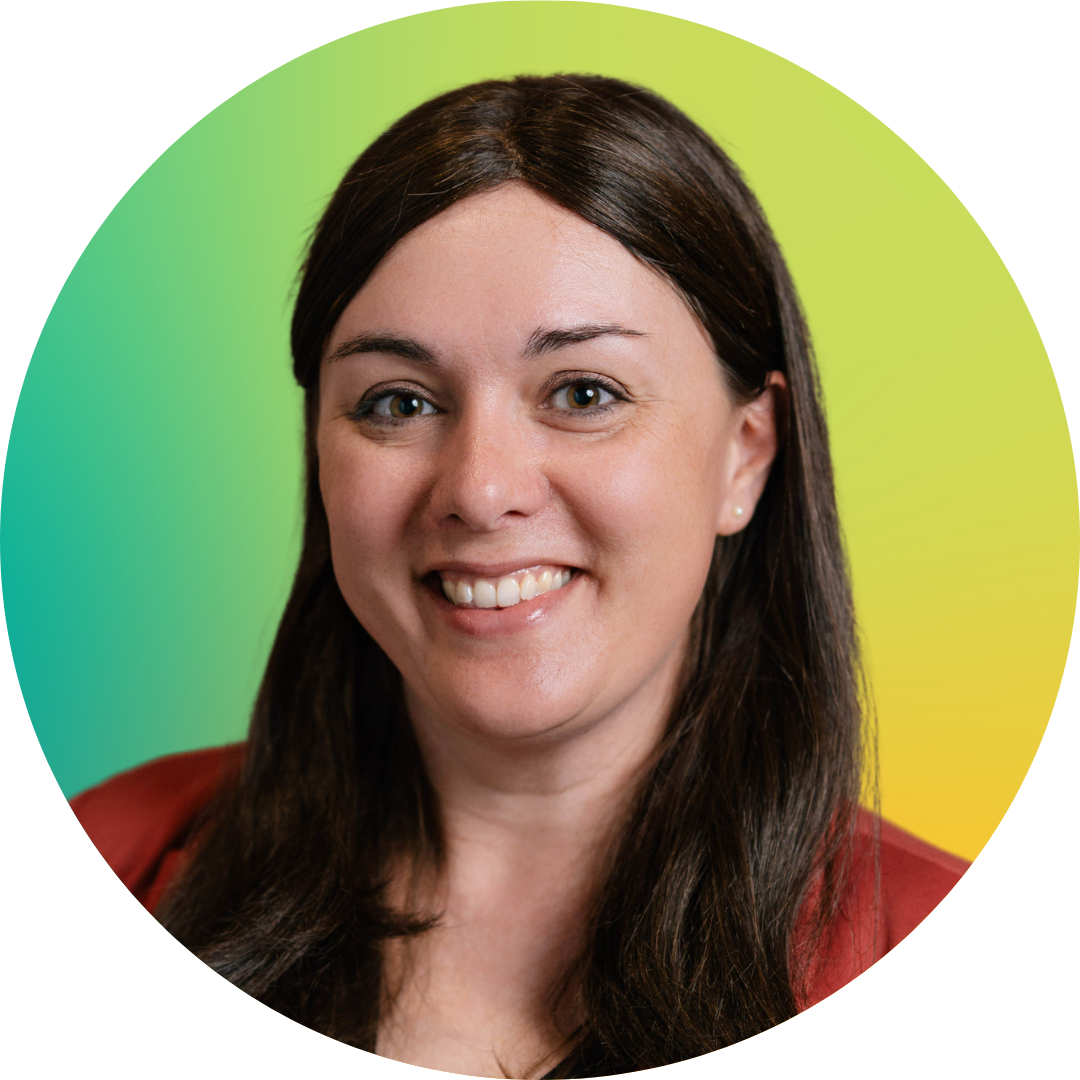
Brittney Linville

Prabhjot Sing

Suzette Jackson


